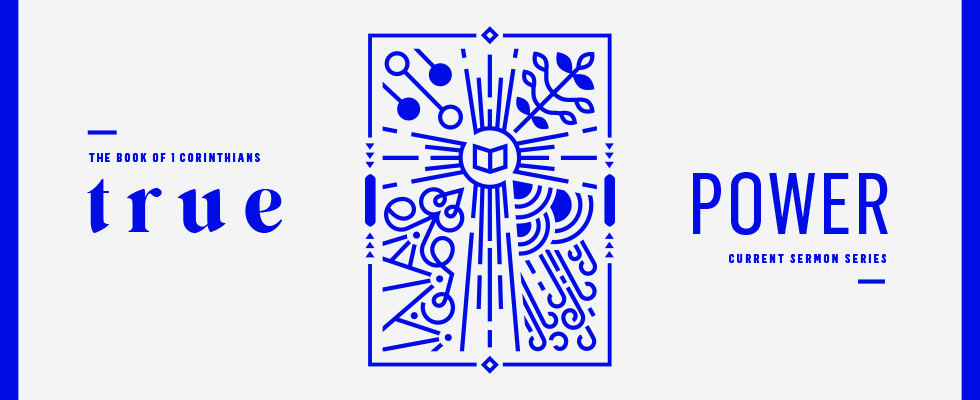Every Sunday, you see this artwork as our pastors faithfully open the Bible and preach the good news. That means that you see it a lot and you may be wondering: what does it mean? What is the symbolism? How does this connect with the book of 1 Corinthians?
These are always great questions—so the purpose of these posts about sermon series' artwork is to help give you a clear understanding of the visuals, so that they might be a support to what you're learning about on Sundays and deepen your understanding of what you're hearing.
First, we'll look at a brief overview of the themes in 1 Corinthians, and then we'll get to the symbolism in the artwork to see how that fits in.
WHO ARE THE CORINTHIANS?
Although the ancient city of Corinth and the city of Vancouver are separated by centuries, they have more in common than one might think.
A hub of international trade, a major business centre, and an attractive city for anyone looking to “get ahead”, Corinth was deeply competitive and a destination for the ambitious. A port city rich in natural resources, the people of Corinth felt in charge of their own lives. They were convinced of their own wisdom and loved to self-promote. Lacking next to nothing, a consumerist mentality ruled.
Sound familiar?
TRUE POWER
If the church in Corinth had followed all of the Apostle Paul’s instructions, they would have looked very different from the culture around them—but sadly, their choices revealed that they truly valued all the same things their culture did.
Because of this, Paul wrote them a letter imploring them to dwell in unity with one another and to overcome the desires of their flesh so that they might truly flourish. He told the Corinthians that they must love others more than themselves and that each member of the body of Christ had been given a spiritual gift (or gifts) that were meant to build up the church.
But where does the power to live out what Paul was calling them to come from? Here are some answers we might get from our culture: get some self-help books, meditate, pull yourself up by your bootstraps, do it to impress others, make up your own moral code—the list goes on, but in this day and age it usually has something to do with activating our own personal, human power.
Power in the Kingdom of God comes from a very different place. Paul showed the Corinthians that they must see each area of their lives through the lens of the gospel. He showed them that the resurrection of Jesus Christ is where true power is found and that it is absolutely central to living out the things they were called to as followers of Jesus.
“For consider your calling, brothers: not many of you were wise according to worldly standards, not many were powerful, not many were of noble birth. But God chose what is foolish in the world to shame the wise; God chose what is weak in the world to shame the strong; God chose what is low and despised in the world, even things that are not, to bring to nothing things that are, so that no human being might boast in the presence of God. And because of him you are in Christ Jesus, who became to us wisdom from God, righteousness and sanctification and redemption, so that, as it is written, ‘Let the one who boasts, boast in the Lord.’”
1 Corinthians 1:26-31
THE ARTWORK
The symbols in the artwork point toward four of the main things Paul is addressing and how the resurrection and the gospel are central to all of them.
Dots and Lines
The dots and lines in the top left corner are meant to represent unity regardless of differences. The dots are different colours, but are still in balance with each other.
The Plant
In the top right corner we have a thriving plant that symbolizes the freedom and flourishing that God has for us when we overcome the desires of the flesh through the work of Jesus and the Holy Spirit.
Wind
On the bottom right we have clouds and wind, symbolizing the Holy Spirit. In Acts it talks about the Spirit coming to the people in this way: “And suddenly there came from heaven a sound like a mighty rushing wind, and it filled the entire house where they were sitting. And divided tongues as of fire appeared to them and rested on each one of them. And they were all filled with the Holy Spirit and began to speak in other tongues as the Spirit gave them utterance.” Acts 2:2-4
Love
On the bottom left we have curved lines that almost make abstract heart shapes with rays coming off of them. These abstract shapes are meant to reflect the radiating love of Christ.
The Cross and The Bible
At the centre of all of these we have the cross, representing the resurrection, and a book icon, representing the gospel. These hold everything together.
Tiffany Pulsifer is married to Chris Pulsifer and serves on staff at Westside as the Director of Creative and Ministry Development. Questions about the artwork? Email creative@wchurch.ca.
